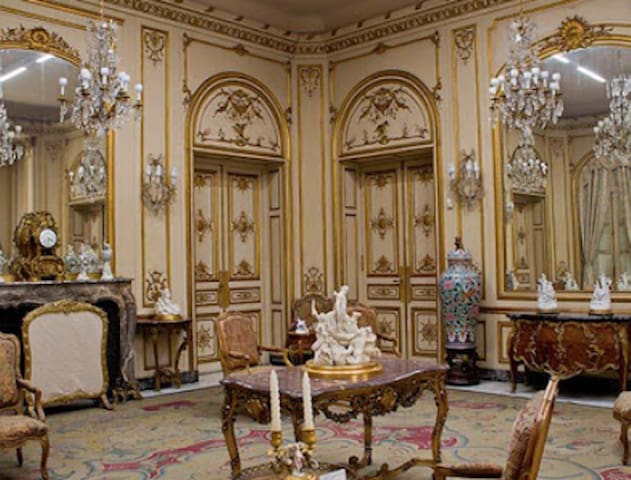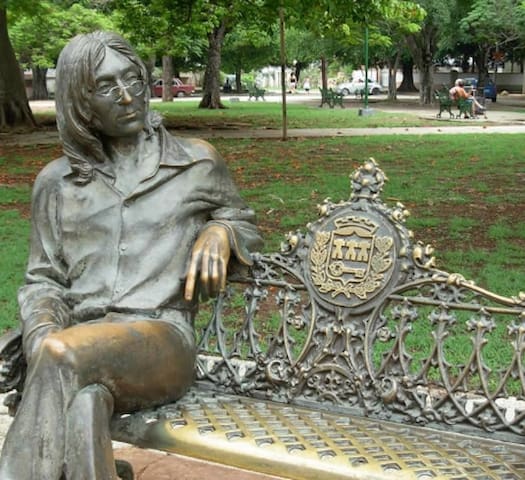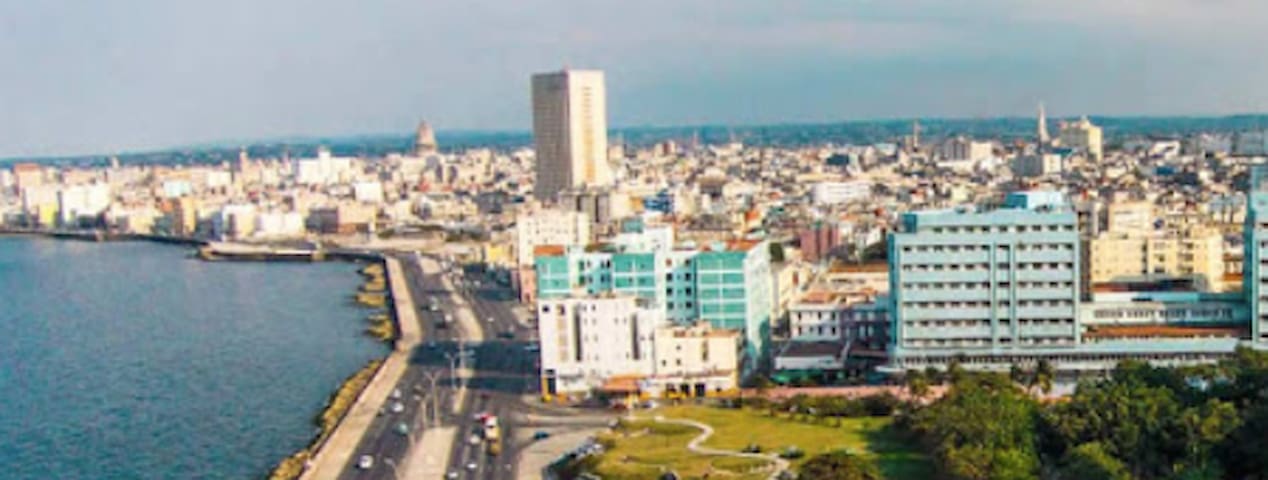Sightseeing
This is an emblematic place about last 70 years Cuba history. You also can find, The José Martí Memorial is a memorial to José Martí, a national hero of Cuba, located on the northern side of the Plaza de la Revolución in the Vedado area of Havana. It consists of a star-shaped tower, a statue of Martí surrounded by six columns, and gardens. It is the largest monument to a writer in the world. The 109 m tower, designed by a team of architects led by Raoul Otero de Galarraga, is in the form of a five-pointed star, encased in grey Cuban marble from the Isla de Pinos. The design was eventually selected from various entries put forward from a series of competitions beginning in 1939. Entries included a version of the tower topped with a statue of Martí, and a monument similar to the Lincoln Memorial in Washington, D.C. with a statue of Martí seated within. The fourth competition held in 1943 resulted in the selection of a design by the architect Aquiles Maza and the sculptor Juan José Sicre.
827 moradores locais recomendam
Praça da Revolução
Avenida PaseoThis is an emblematic place about last 70 years Cuba history. You also can find, The José Martí Memorial is a memorial to José Martí, a national hero of Cuba, located on the northern side of the Plaza de la Revolución in the Vedado area of Havana. It consists of a star-shaped tower, a statue of Martí surrounded by six columns, and gardens. It is the largest monument to a writer in the world. The 109 m tower, designed by a team of architects led by Raoul Otero de Galarraga, is in the form of a five-pointed star, encased in grey Cuban marble from the Isla de Pinos. The design was eventually selected from various entries put forward from a series of competitions beginning in 1939. Entries included a version of the tower topped with a statue of Martí, and a monument similar to the Lincoln Memorial in Washington, D.C. with a statue of Martí seated within. The fourth competition held in 1943 resulted in the selection of a design by the architect Aquiles Maza and the sculptor Juan José Sicre.
The Napoleon Museum in Havana, Cuba houses one of the most important collections from the 18th and 19th centuries preserved in the Western hemisphere. The Museum reopened in March 2011 after a three-year restoration by the City Historian’s Office. Napoleon Princess Alix de Foresta, widow of Luis Marie Bonaparte, a descendant of King Jerome, Bonaparte’s younger brother, was especially invited to the island for the opening. The museum was founded in 1961, with the collection of Julio Lobo, occupying a 1929 Florentine Renaissance style mansion "La Dolce Dimora", the home of an Italian-Cuban politician, Orestes Ferrara. The architects were Evelio Govantes and Félix Cabarrocas, whose also designed El Capitolio and the Casa de la Amistad on Paseo. The museum displays almost 8,000 items, most of them related to the period from the French Revolution through the Second Empire. The collection includes a specialized library, suits, weapons, military equipment, furniture, coins, historic and decorative objects. Artwork is displayed from Louis Tocqué, Jean-Marc Nattier, Nicolas de Largillière, Jean Baptiste Regnault; François Flameng, Andrea Appiani and Robert Léfèvre
216 moradores locais recomendam
Museu Napoleão
The Napoleon Museum in Havana, Cuba houses one of the most important collections from the 18th and 19th centuries preserved in the Western hemisphere. The Museum reopened in March 2011 after a three-year restoration by the City Historian’s Office. Napoleon Princess Alix de Foresta, widow of Luis Marie Bonaparte, a descendant of King Jerome, Bonaparte’s younger brother, was especially invited to the island for the opening. The museum was founded in 1961, with the collection of Julio Lobo, occupying a 1929 Florentine Renaissance style mansion "La Dolce Dimora", the home of an Italian-Cuban politician, Orestes Ferrara. The architects were Evelio Govantes and Félix Cabarrocas, whose also designed El Capitolio and the Casa de la Amistad on Paseo. The museum displays almost 8,000 items, most of them related to the period from the French Revolution through the Second Empire. The collection includes a specialized library, suits, weapons, military equipment, furniture, coins, historic and decorative objects. Artwork is displayed from Louis Tocqué, Jean-Marc Nattier, Nicolas de Largillière, Jean Baptiste Regnault; François Flameng, Andrea Appiani and Robert Léfèvre
John Lennon Park or Parque John Lennon is a public park, located in the Vedado district in Havana, Cuba.
217 moradores locais recomendam
Parque Lennon
Calle 8John Lennon Park or Parque John Lennon is a public park, located in the Vedado district in Havana, Cuba.
Cultural Center
La Fábrica de Arte Cubano is an art gallery and club in Havana, Cuba. The Fábrica's gallery and stage were established inside of a former cooking oil factory, and has since gained notoriety as one of Havana's premier nightclubs and art galas
1420 moradores locais recomendam
Fábrica de Artes Cubanas
& Calle 26La Fábrica de Arte Cubano is an art gallery and club in Havana, Cuba. The Fábrica's gallery and stage were established inside of a former cooking oil factory, and has since gained notoriety as one of Havana's premier nightclubs and art galas
Neighbourhoods
Vedado is a central business district and urban neighborhood in the city of Havana, Cuba. Bordered on the east by Calzada de Infanta and Central Havana, and on the west by the Alemendares River and Miramar / Playa district, Vedado is a more modern part of the city than the areas to the east, developed in the first half of the 20th century, during the Republic period. In 2016 it was described by one commentator as the city's "most affluent" section.[1] The main street running east to west is Calle 23, also known as "La Rampa". The northern edge of the district is the waterfront seawall known as the Malecón, a famous and popular place for social gatherings in the city. The area popularly referred to as 'Vedado' consists of the wards (consejos populares) of Vedado, Rampa, Vedado-Malecón and Carmelo, all in the municipality of Plaza de la Revolución.
140 moradores locais recomendam
Vedado
Vedado is a central business district and urban neighborhood in the city of Havana, Cuba. Bordered on the east by Calzada de Infanta and Central Havana, and on the west by the Alemendares River and Miramar / Playa district, Vedado is a more modern part of the city than the areas to the east, developed in the first half of the 20th century, during the Republic period. In 2016 it was described by one commentator as the city's "most affluent" section.[1] The main street running east to west is Calle 23, also known as "La Rampa". The northern edge of the district is the waterfront seawall known as the Malecón, a famous and popular place for social gatherings in the city. The area popularly referred to as 'Vedado' consists of the wards (consejos populares) of Vedado, Rampa, Vedado-Malecón and Carmelo, all in the municipality of Plaza de la Revolución.
Conselho para os viajantes
Transporte
Taxis, Colectivos Cuban Taxis, walking, Tour Bus, Bus
Cuba has come transportation issues. There is not subways and the bus system does not has a timing. Getting colectivos taxis is a inexpensive way to commute.
Transporte
Colectivos taxis the cheapest way to get around
Cuba has not subway. Being a poor country the transportation is not the greatest ever. You will find privet taxis who ask for high prices. So, you can have the information at the house about the aceptable prices to avoid paying too much. Also, we can advise about other ways to get around the city or other provinces.





